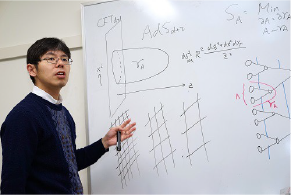 With the advent of the quantum information age, there is a need for a revolution in physics. Theoretical physics has been divided into different fields such as particle theory, condensed matter theory, and cosmology, depending on the length scale. However, by introducing the ideas of quantum information and gauge-gravity correspondence, it is becoming clear that what underlies all these theories is actually the same.
With the advent of the quantum information age, there is a need for a revolution in physics. Theoretical physics has been divided into different fields such as particle theory, condensed matter theory, and cosmology, depending on the length scale. However, by introducing the ideas of quantum information and gauge-gravity correspondence, it is becoming clear that what underlies all these theories is actually the same.
By considering quantum information as a fundamental component of the natural world, the "Extreme Universe" project aims at elucidating three subjects that are expected to make great progresses: the quantum theory of black holes (quantum black holes), the mechanism of the creation of the universe (quantum universe), and the dynamics of quantum matter, through the fusion of different fields of quantum information and physics. At first glance, these three topics may seem to be separate, but from the perspective of quantum information, they can all be viewed as the dynamics of a collection of qubits. We call them "extreme universe" because they challenge the "limit of space", the "limit of time", and the "limit of matter", respectively. In this area, we not only conduct theoretical research that integrates quantum information theory and theoretical physics, but also perform experimental simulations of black holes and the creation of the universe through condensed matter experiments of cold atoms and the quantum Hall effect using relatively compact devices.
Based on my own experiences, the driving force for change in interdisciplinary fusion is, after all, young researchers. In this field, we would like to inspire young researchers to participate in fusion research through interdisciplinary meeting, long-term stay programs in interdisciplinary research groups, and visits to foreign institutions. Through these research activities, we will make an innovative contribution to this interdisciplinary field, which is expected to grow significantly in the future.
Head Investigator
Tadashi Takayanagi Yukawa Institute for Theoretical Physics, Kyoto University
